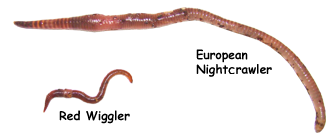Red Wiggler Worms - All-natural Remedy for Eco-friendly Composting
Red Wiggler Worms - All-natural Remedy for Eco-friendly Composting
Blog Article
Red Wiggler Worms Demystified: Unlocking the Keys of Vermiculture for Greener Living and Nutrient-Rich Dirt
In the world of sustainable practices for improving dirt quality and promoting eco-conscious living, red wiggler worms play an essential yet typically ignored role. Red Wiggler Worms. Understanding the ins and outs of caring for these worms, optimizing their atmosphere, and using their castings can lead to a greener way of life and healthier soil for plants to grow.
The Function of Red Wiggler Worms
Red Wiggler worms play a vital duty in composting systems by efficiently damaging down natural issue into nutrient-rich castings. These voracious eaters consume a selection of natural materials, such as kitchen area scraps, yard waste, and paper items. As they feed, the worms' digestion procedures damage down the natural issue right into a fine, dark, and nutrient-dense material referred to as worm castings or vermicompost.
The castings created by Red Wiggler worms are very valuable for soil health and wellness and plant development. They are abundant in important nutrients like potassium, phosphorus, and nitrogen, which are vital for supporting healthy and balanced plant growth. In addition, worm castings consist of advantageous microorganisms and enzymes that help enhance dirt framework, boost water retention, and enhance nutrient uptake by plants.
Advantages of Vermicomposting

It boosts soil framework, boosts soil oygenation, and increases soil moisture retention. Vermicompost additionally enriches the soil with essential nutrients like potassium, nitrogen, and phosphorus, advertising plant growth and general dirt fertility.
Furthermore, vermicomposting assistances lasting horticulture methods by supplying a all-natural and chemical-free alternative to synthetic fertilizers. Red Wiggler Worms. This ecologically pleasant technique not just improves the dirt but also assists decrease dependence on hazardous chemicals, promoting a greener and extra lasting way of horticulture
Establishing Up a Worm Bin
When developing a worm container for vermicomposting, correct configuration is essential to make certain the success of the composting process. The very first step in establishing a worm container is selecting an appropriate container. This can be a plastic container or wooden box that provides enough space for the worms to walk around and has proper drainage holes to stop waterlogging. Next off, a bedding product such as shredded paper, cardboard, or coconut coir should be included in the bin. This bedding provides a comfy setting for the worms and helps maintain moisture levels.
After adding the bedding, introduce the red wiggler worms to the container. It is advised to begin with a tiny number of worms and progressively raise as they increase. The worms should after that be offered with food scraps such as vegetables and fruit peels, coffee premises, and eggshells. It is vital to prevent adding meat, milk, oily, or salty foods to stop bring in bugs and creating undesirable odors.
Regularly keep track of the dampness levels and temperature level in the worm container to make certain ideal conditions for the worms. With proper setup and maintenance, the worm bin will properly convert natural waste right into nutrient-rich compost for your plants and yard.
Collecting Worm Castings
To successfully collect nutrient-rich worm spreadings from your vermicomposting system, a systematic harvesting technique is important. When it comes time to collect the worm castings, there are a couple of essential actions to follow to make certain a successful procedure. Quit adding fresh food scraps to one side of the worm container for a pair of weeks before gathering. This encourages the worms site link to move sideways with fresh bed linens and food, making it much easier to scoop out the castings from the opposite.

Troubleshooting Common Issues
Identifying and addressing common obstacles that might emerge throughout the vermicomposting process is crucial for keeping a effective and healthy and balanced worm bin. Including excess food scraps can lead to a buildup of dampness and level of acidity in the worm bin, possibly hurting the worms. One more issue is undesirable odors emanating from the worm bin.
In addition, if the worm population is declining or the worms show up harmful, maybe due to environmental stress factors such as extreme temperatures or pH degrees. Keeping track of these variables and making necessary modifications is essential for the wellness of the worms. By repairing these common problems immediately, vermicomposters can make certain a successful and smooth vermicomposting procedure while preserving a growing worm population.

Verdict
Finally, red wiggler worms play a crucial role in vermiculture by breaking down raw material right into nutrient-rich dirt. The advantages of vermiculture include greener living and enhanced soil quality. Establishing up a worm container is crucial for effective vermiculture, and gathering worm castings offers important compost for gardening. By recognizing and troubleshooting usual concerns, people can unlock the secrets of vermiculture for lasting living and much healthier dirt.
As they feed, the worms' digestive processes break down the organic matter right into a fine, dark, and nutrient-dense material understood as worm castings or vermicompost.
The spreadings generated by Red Wiggler worms are highly helpful for dirt wellness and plant development. Adding excess food scraps can lead to an accumulation of moisture and acidity in the worm bin, potentially harming the worms.Additionally, if the directory worm population is declining or the worms appear unhealthy, it can be due to ecological stress factors such as extreme temperature levels or pH levels. Establishing up a worm bin is essential for effective vermiculture, and harvesting worm spreadings offers beneficial compost for horticulture.
Report this page